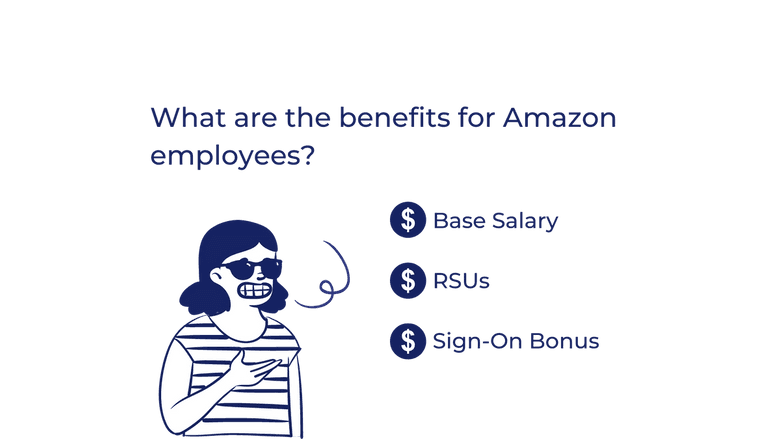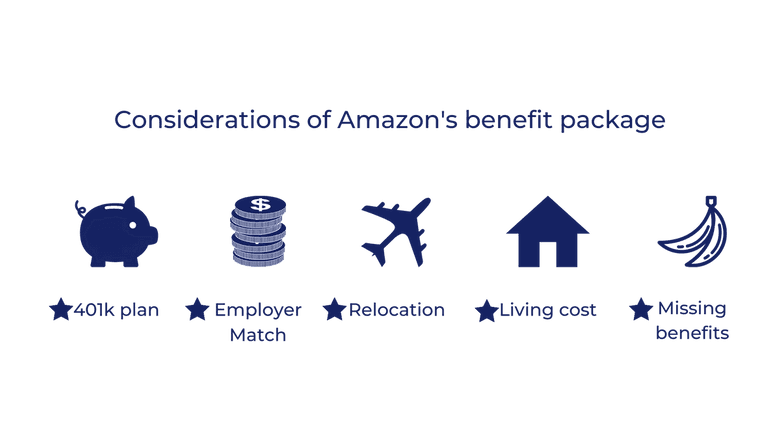Amazon 401k and all about the free bananas
Amazon may be a FANG, but their benefits make us say "oh dang".

Receiving a six-figure offer as a software engineer from Amazon presents a dizzying array of opportunities. If this is your first role at FAANG, you're probably beyond excited.
Taper your enthusiasm. Their total compensation may be comfortable, but Amazon benefits are anything BUT competitive. Plus, Amazon pays for retention. If you don't stay, you can't play.
So, we're going to help you weigh your options. We'll benchmark Amazon’s compensation, 401K match, relocation, and other benefits for software engineers. Compared to other tech giants, is Amazon the place to continue your career?
First, Let's Talk Compensation Package

According to retirement savings calculations done by Brightscope, a small difference in compensation can make a big difference in financial goals over the course of a career. But, with a mobile workforce that changes jobs every 4-4.5 years on average, many are not capitalizing on growing benefits over the long-term.
Amazon, unlike many other tech companies, plays a long game to develop and retain talent. Over time, this may equalize overall compensation based on tenure and company performance. However, this also means that if you don't stay past 3 years, you miss out on earnings and benefits. And (spoiler alert) the average tenure at Amazon is pretty short term. According to LinkedIn data, it's only 2.3 years.
Base Pay: Your Starting Point
Many report a base pay "salary gap” for Amazon versus other technology giants. Base pay for the title “software engineer” shows:
- Facebook ($224K)
- Google ($203K)
- Microsoft ($144K)
- Amazon ($135K)
Restricted Stock Units (RSU)
These may be Amazon's great equalizer. Not all stocks are created equal in big tech. A distribution and vesting plan, like the one offered by Amazon, is structured to equalize pay disparity through strong company stock performance. It is also structured for the goal of increased employee retention.
Amazon stock takes the form of RSUs. They are paid out over four years with an increased vestment each year, starting with 10% for year one. Above average stock performance over time may equalize (or increase) Amazon compensation compared to other tech giants.
Sign-On Bonus
The Pros: Amazon offers 92% of new hires a sign-on bonus, which is better than Facebook (83%) or Microsoft (80%). Their bonuses are also notoriously large. In fact, a significant percent of your cash pay with Amazon depends on your sign-on bonus, which is distributed in years 1 and 2. And when I say large- I mean it! This can be up to 35% of your total compensation.
The Cons: Amazon often doles out this compensation per month rather than as a lump sum. The downside is that the bonus “disappears” from a paycheck after one or two years. However, if an employee moves on before year two, there is no prorated payback.
The Benefits – Make an Informed Decision

Amazon’s 401K Plan and Company Match
Employee contributions are highly encouraged by most big companies, and Amazon is no exception. Many employers match contributions of annual payroll compensation.
401K plan logistics:
- Amazon 401K vesting is after three years. This means that you will not get your match if you leave before the 3rd year. For comparison, Microsoft and Facebook vest immediately.
- Often, Amazon pays out in company stock, but employees can redirect per their personal financial plan. For 2020, Amazon’s more than $5.7 billion worth of portfolios has been moved from Vanguard to Fidelity Investments.
Employer match:
- Amazon matches 50 percent of pay (as of 2018). This policy applies to all employees, full-time or part-time. For comparison, Facebook, Google, and Microsoft also match 50 percent of pay
- Amazon will match up to 4 percent of eligible pay and catch-up contributions are NOT matched. For comparison, competitors Microsoft and Facebook boast 6 and 7 percent (respectively)
Relocation Packages at Amazon
Like most large companies, Amazon offers varied and generous relocation packages. There are 2 structures to choose from:
- Lump Sum: A single cash payment that can be used toward any moving expenses. At Amazon, it's often around $20K with some tax advantages.
- Relocation Package: Packages include travel expenses, moving costs, home rentals, car rentals, and other costs associated with moving. In addition to housing and moving services, a cash component may also be included.
On average, Amazon employees receive $20,000 to relocate ($40k if you have a larger move) and Amazon often includes a few months of housing, or help from a realtor to find a place in Seattle.
If you're a renter, it's not uncommon to get a few months of rent paid for, although you may receive a smaller cash package as a result. However, don't expect a palace -- we recently spoke to an incoming engineer, whose family of 4 was offered a 1 bedroom apartment.
This is a highly negotiable component. But beware - these benefits are clawed back if you leave within a year or if you never end up moving.
Cost of Living
Employees at Amazon and Microsoft in Seattle enjoy a lower cost of living ratio than Silicon Valley, the home of Facebook, Apple, and Google.
Bankrate.com reports a 32% cost of living advantage living and working in Seattle versus Silicon Valley.
However, all of these technology giants have satellites throughout the country that may offer even better ratios, with a caution that this may reduce corporate visibility.
Other Considerations
Amazon’s frugality is realized in its mission to “invent and simplify.” For that, Amazon enjoys a stellar business reputation, with customers ranking second in a 2019 Harris Poll. No other tech giant made the top five. Employees hold it in high regard as well, as 74% of current Amazon employees recommend work opportunities for their friends.
However, frugality also shows in the lack of benefits compared to other companies of the same size and caliber. One notable example - there is no free food for employees, just bananas as a snack in the company kitchens.
While that may sound funny, the reality is much more grim: some of the other missing benefits include student loan payment match, educational grants, family planning benefits, and other things that can make a massive dent in your budget.
Keep in mind... While working at Amazon isn't for everyone, plenty of top talent sticks around - more than 36 percent of Amazon employees are logging five to ten years of service.
The information provided herein is for general informational purposes only and is not intended to provide tax, legal, or investment advice and should not be construed as an offer to sell, a solicitation of an offer to buy, or a recommendation of any security by Candor, its employees and affiliates, or any third-party. Any expressions of opinion or assumptions are for illustrative purposes only and are subject to change without notice. Past performance is not a guarantee of future results and the opinions presented herein should not be viewed as an indicator of future performance. Investing in securities involves risk. Loss of principal is possible.
Third-party data has been obtained from sources we believe to be reliable; however, its accuracy, completeness, or reliability cannot be guaranteed. Candor does not receive compensation to promote or discuss any particular Company; however, Candor, its employees and affiliates, and/or its clients may hold positions in securities of the Companies discussed.
